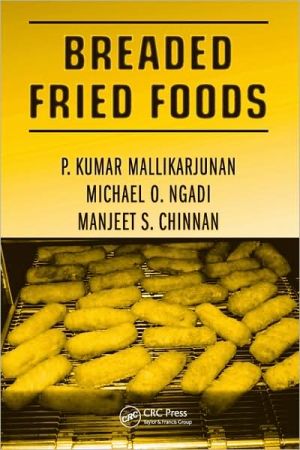

 |

|

Sold Out
Book Categories |
Preface xi
The Authors xiii
Chapter 1 Introduction 1
1.1 Frying and Fried Foods 1
1.2 Coated Fried Foods 4
1.3 Challenges in Coated Fried Foods 5
1.4 References 5
Chapter 2 Principles of Deep-Fat Frying 7
2.1 Frying as a Unit Operation 7
2.2 Heat Transfer 8
2.3 Moisture Transfer 12
2.4 Fat Transfer 13
2.5 Moisture and Fat Transfer in Coated Products 14
2.6 Crust Formation 18
2.7 Mathematical Modeling 18
2.7.1 Single Layer Models 19
2.7.2 Composite Layer Models 21
2.7.2.1 Modeling Moisture Transfer 26
2.7.2.2 Modeling Fat Transfer 27
2.8 References 28
Chapter 3 Fryer Technology 33
3.1 Basic Components of a Frying System 34
3.1.1 Heating Systems 35
3.1.1.1 Direct Heating System 35
3.1.1.2 Indirect Heating System 35
3.1.1.3 External Heating System 36
3.1.2 Fryer Filtration 39
3.2 Restaurant and Food Service Frying Equipment 39
3.3 Industrial Frying Equipment 43
3.4 Critical Factors in Selection of Frying Equipment 45
3.4.1 Fryer Capacity 45
3.4.2 Heat Load 46
3.4.3 Delt-a-T (?T) in the-Fryer 47
3.4.4 Conveyors 47
3.4.5 Temperature Recovery Time 47
3.4.6 Oil Turnover Time 48
3.4.7 Fryer Oil Filtration 48
3.4.8 Emissions 49
3.4.9 Cleaning and Maintenance 49
3.5 Ideal Fryer 49
3.6 Recent Developments in Fryer Technology 50
3.6.1 Modifications of Head Space Gas Composition and Pressure 51
3.7 Future Outlook 51
3.8 References 52
Chapter 4 Frying Oil 53
4.1 Frying Oil Quality 53
4.1.1 Oil Degradation 55
4.1.2 Chemical Changes in Oil 56
4.1.2.1 Hydrolysis 56
4.1.2.2 Polymerization 56
4.1.2.3 Surfactants 57
4.1.3 Physical Changes in Oil 58
4.2 Measuring Oil Quality 58
4.2.1 Chromatography59
4.2.2 RAU Test 60
4.2.3 Fritest and Oxifrit 60
4.2.4 Color 61
4.2.5 Spot Test 61
4.2.6 Food Oil Sensor 62
4.2.7 Polar Compound Tester 63
4.2.8 Viscosity 64
4.2.9 Fri-Check U nit 65
4.2.10 Acid Value 66
4.3 Recent Developments in Improving Oil Quality 66
4.3.1 Prolonging the Frying Oil Life 66
4.3.2 Filtration and Filter Aids 67
4.3.2.1 Effect of Sequential Addition of Adsorbent 68
4.3.2.2 Effect of Filter Aids on Oil Quality Abused under Commercial Frying Conditions 68
4.4 Recent Developments in Oil Quality Measurement 71
4.4.1 Electronic Nose 71
4.4.2 Fourier Transformation Infra Red (FTIR) Spectroscopy 72
4.5 References 76
Chapter 5 Batter and Breading-Classification and Processing Systems 81
5.1 Introduction 81
5.1.1 Definition of Batter and Breading 82
5.2 Batter Classifications 82
5.2.1 Interface/Adhesion Batter.83
5.2.2 Puff/Tempura Batter 83
5.3 Breading Classifications 83
5.4 Critical Coating Characteristics 84
5.4.1 Color and Appearance 84
5.4.2 Crispness 85
5.4.3 Texture 86
5.4.4 Flavor 86
5.4.5 Moisture and Oil Content 87
5.5 The Marketing of Batter and Breading Products 87
5.6 Batter and Breading Process Equipment 88
5.6.1 Batter and Breading Process 88
5.6.2 Characteristics of Process and Equipment 90
5.7 Application of Batters and Breading 92
5.7.1 Vegetables and Cheeses 93
5.7.2 Seafood 93
5.7.3 Poultry 94
5.7.4 Red Meat 95
5.8 References 95
Chapter 6 Properties of Batters and Breadings 97
6.1 Rheological Properties of Batters 97
6.1.1 Batter Viscosity 98
6.1.2 Viscoelastic Behavior of Batter during Gelatinization 104
6.2 Porosity 107
6.3 Adhesion 109
6.4 Particle Size 109
6.5 References 110
Chapter 7 Batter and Breading Ingredients Selection 113
7.1 Functionality of Ingredients 113
7.1.1 Flour 113
7.1.2 Starch 114
7.1.3 Protein 116
7.1.4 Chemical Leavening 117
7.1.5 Shortening and Oil 117
7.1.6 Eggs 117
7.1.7 Milk and Whey 118
7.1.8 Flavoring and Seasoning 118
7.1.9 Salt and Sugar 118
7.1.10 Hydrocolloids 118
7.2 Formulation of Batter and Breading Systems 120
7.2.1 Batter System 121
7.2.2 Breading System 121
7.3 Breading and Batter Selection 122
7.4 References 122
Chapter 8 Measuring the Quality of Breaded Fried Foods 125
8.1 Oil Uptake and Yield 125
8.2 Breading Pickup and Adhesion 127
8.3 Color and Appearance 127
8.4 Juiciness 29
8.5 Crispness 129
8.5.1 Batters and Breading for Fried Food and Their Significance to Crispness 130
8.5.2 Crispness and Crunchiness 131
8.5.3 Characterization and Determination of Crispness 132
8.5.3.1 Structural and Geometrical Properties 132
8.5.3.2 Mechanical Properties 132
8.5.3.3 Acoustical Properties 133
8.5.3.4 Combination Measurements 137
8.5.3.5 Future Trends 138
8.5.4 Parameters Controlling Crispness 139
8.5.4.1 Process and Structure 139
8.5.4.2 Ingredients and Hydration 140
8.5.4.3 Others 140
8.6 Other Textural Attributes 141
8.6.1 Shear Test 141
8.6.2 Puncture Test 143
8.6.3 Textural Profile Analysis 143
8.7 References 145
Chapter 9 Recent Technologies to Enhance the Quality of Fried Foods 149
9.1 Reduction of Oil Uptake of Fried Products 149
9.1.1 Pre-Fry Techniques 150
9.1.2 Post-Frying Techniques 151
9.1.3 Edible Films, Batters, and Breadings 151
9.1.4 Modification of Frying Medium 157
9.1.5 Other Methods to Reduce Oil Uptake 158
9.2 Enhancing Crispness in Breaded Fried Products 158
9.3 References 161
Abbreviations 165
Index 169
Login|Complaints|Blog|Games|Digital Media|Souls|Obituary|Contact Us|FAQ
CAN'T FIND WHAT YOU'RE LOOKING FOR? CLICK HERE!!! X
 You must be logged in to add to WishlistX
 This item is in your Wish ListX
 This item is in your CollectionBreaded Fried Foods
X
 This Item is in Your InventoryBreaded Fried Foods
X
 You must be logged in to review the productsX
 X
 X

Add Breaded Fried Foods, Despite the hype about healthy, low-carb/low-fat diets, the production of deep-fat fried foods continues to be a major processing operation around the world, generating billions of dollars each year. Due to their uniquely crispy exterior and juicy interio, Breaded Fried Foods to the inventory that you are selling on WonderClubX
 X

Add Breaded Fried Foods, Despite the hype about healthy, low-carb/low-fat diets, the production of deep-fat fried foods continues to be a major processing operation around the world, generating billions of dollars each year. Due to their uniquely crispy exterior and juicy interio, Breaded Fried Foods to your collection on WonderClub |